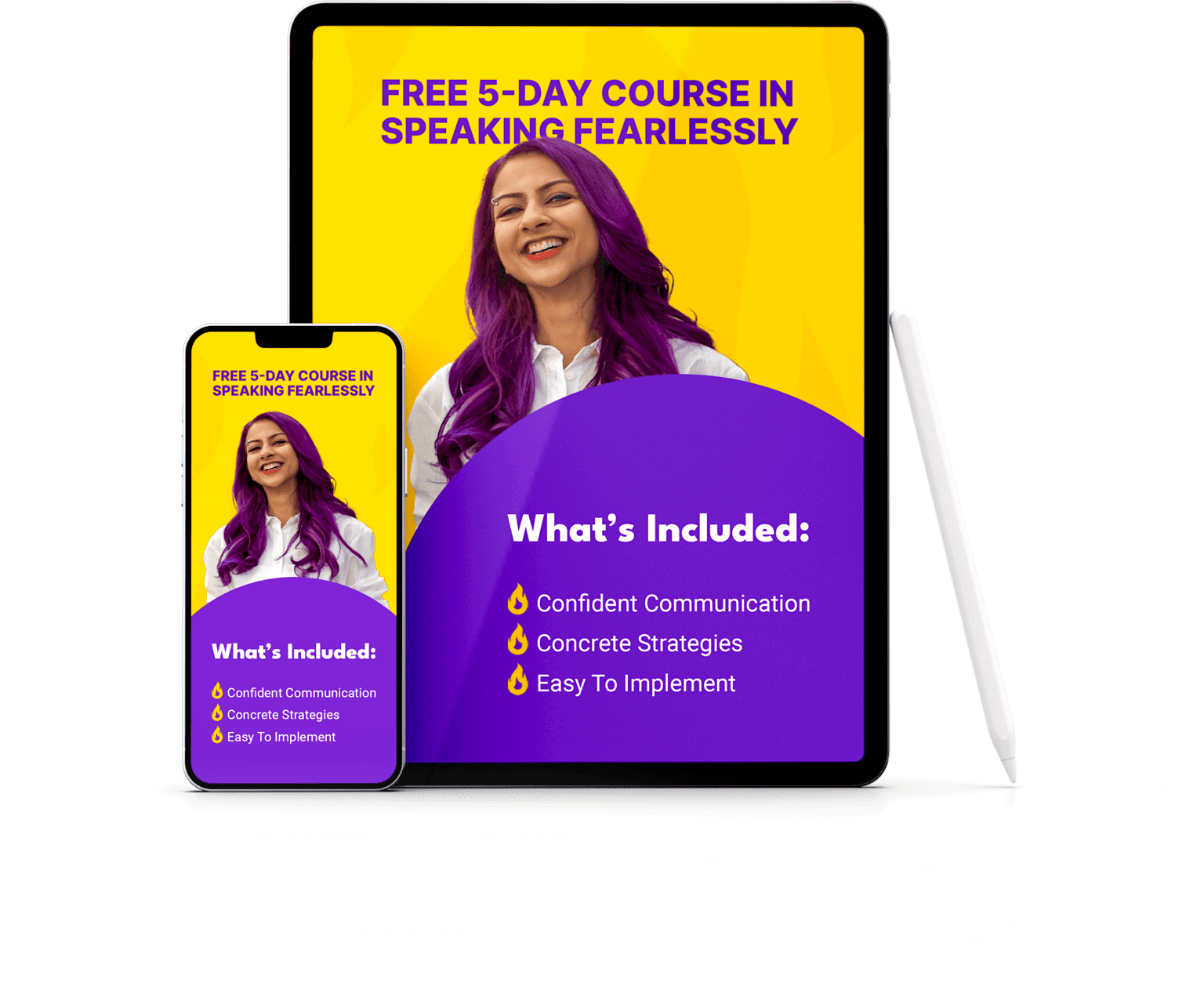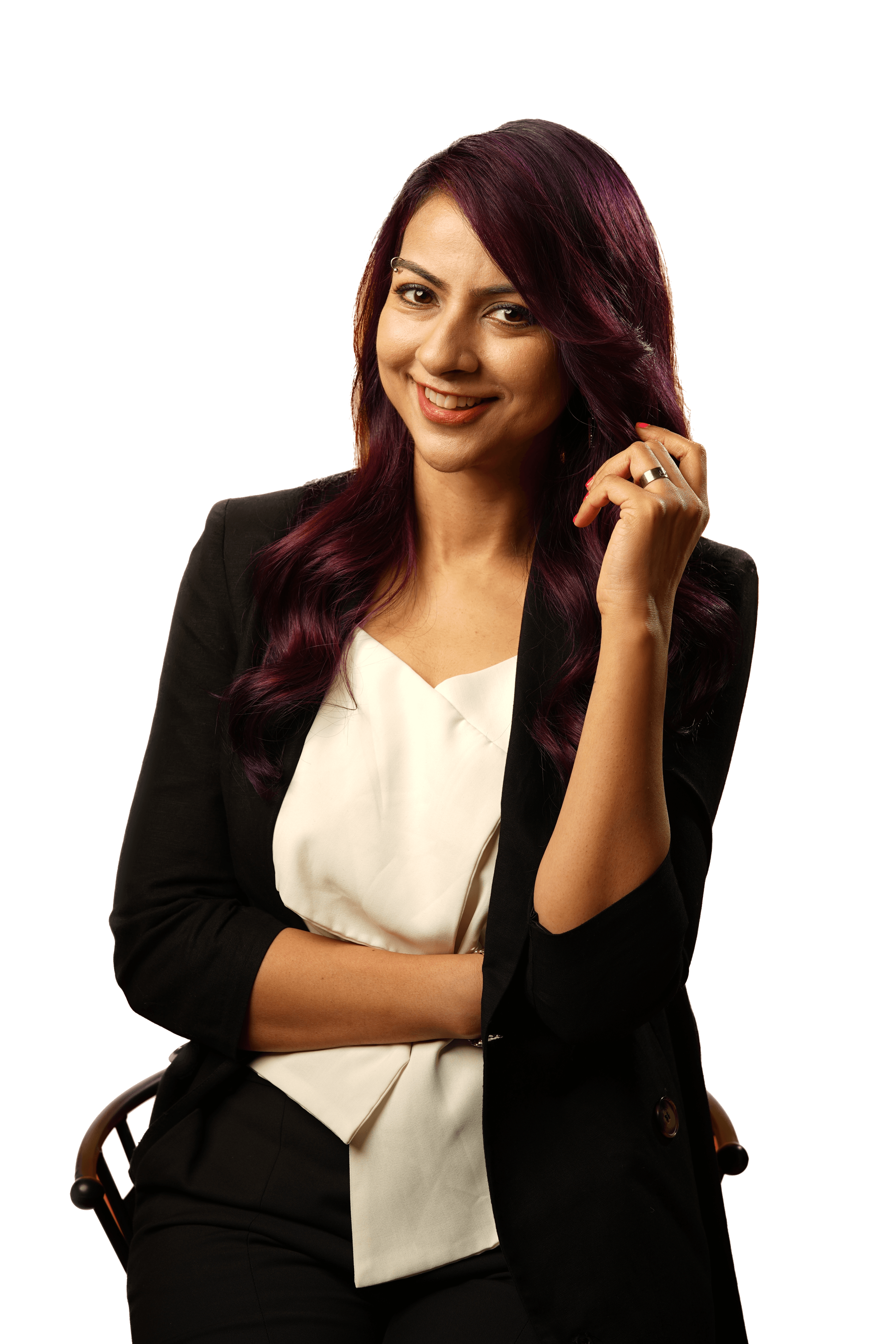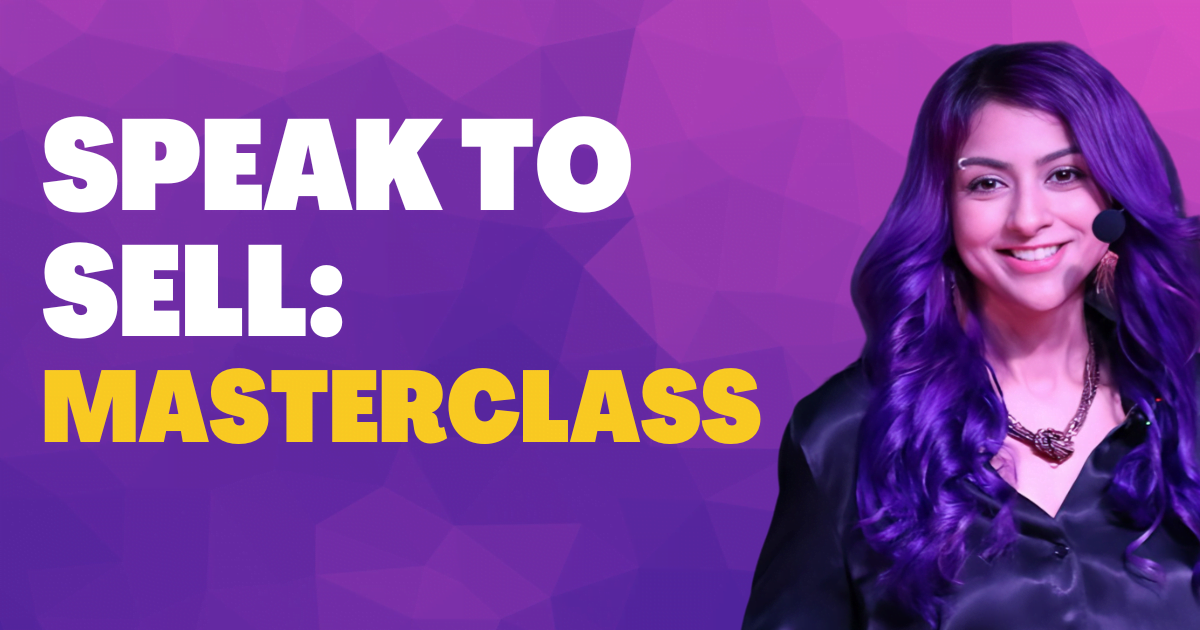Podcasting builds on your personal brand as an entrepreneur and boosts your business growth. We use LinkedIn, X, Instagram to build our brands but we forget that podcasts are one of the best middle-of-funnel activities to gain more clients and grow our business.
I encourage every entrepreneur to have a voice and start a podcast. Know that you can make money with podcasting, but too many people jump right in without thinking about all the options available to them!
The podcast world is diverse – don’t box yourself into a type, format, or topic until you’ve done your research. That’s what you’re here for today.
You’re about to read everything you need to know, mull over, and decide before starting on this great adventure.
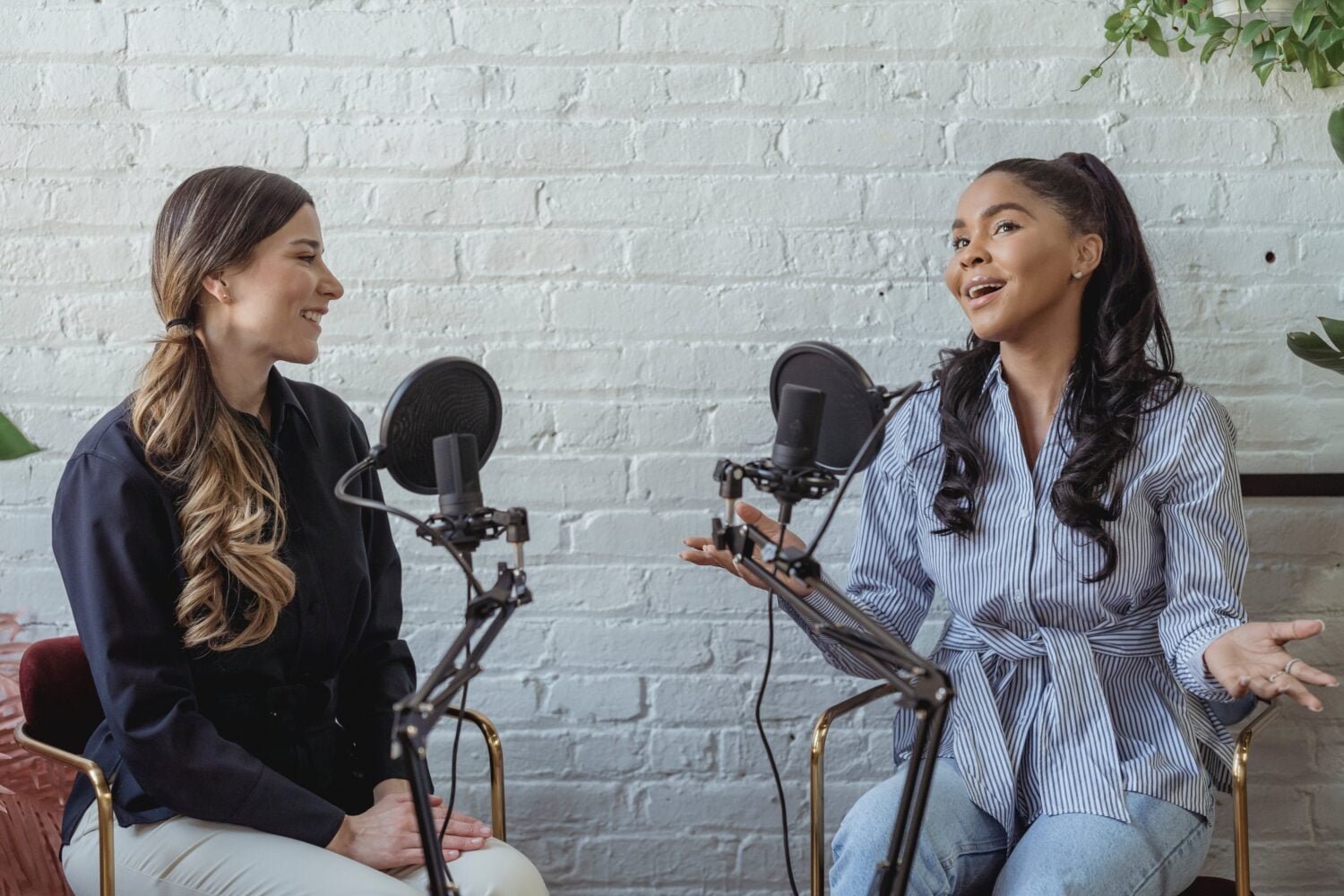
Table of Contents
You might be wondering…
Why should you listen to me?
Because I live and breathe speaking in public! I’ve coached 300+ entrepreneurs on how to speak on camera, on live events and on podcasts to grow their brands. I created and grew my own podcast Speak as a Leader, where I’ve hosted senior directors and intrapreneurs from Google, Amazon, IBM and even leaders who have served at the Pentagon. I’ve guested on 100+ podcasts, and I’m a total podcast nerd, of course!
I’m in a unique position to share insights on how subject-matter experts like you can speak like the thought leaders you are.
How does a podcast help with brand building?
Perhaps you’re already posting on LinkedIn. You’re writing a newsletter. But your audience wants to get to know you in a more direct and deeper way. Creating a podcast gives them a chance to see how you talk and watch you share real-time insights. It’s the perfect content to warm up leads and build brand loyalty by letting your audience get to know you more intimately.
By starting a podcast, you can share insights, expertise and even showcase the expertise of others. It’s a long-form medium that’s designed to interact with your audience.
Your audience will engage with you not just for a few seconds on a social media post, but for many minutes (or even hours). That’s why the impact that a podcast can have on your brand is immense. Talk about feeding two birds with one scone!
How to choose a topic for your podcast
You might have an idea of what you want your podcast to be about, especially if its main raison d’être is to serve your business. But before you commit, do your research.
Before starting a podcast, answer these questions:
- Who is your target audience?
- What are their biggest challenges?
- What are they already listening to?
- What content is there demand for?
- What are you in a unique position to talk about?
Do a deep dive into what your audience is searching for using tools like SEMRUSH, AHRefs or hiring an SEO specialist. If a topic is being searched for by many people (or getting “hits” on Google), you can assume that some of those people are prospects.

The unglamorous start to every podcast – meticulous research and note-taking.
Photo by Daniel Chekalov on Unsplash
I chose my podcast topic — speaking as a leader – because a lot of entrepreneurs and execs are subject matter experts but don’t do justice to their expertise when they speak. So I wanted to create a podcast to help them show up as the leaders they are every time they speak to an audience.
Pro-tip: Your podcast shouldn’t just exist to sell your product or service. Your audience will not be interested in just being sold to. Think about how your podcast can help your prospective clients – to be able to win their hearts and their wallets.
How to name your podcast
Photo by Mohammad Metri on Unsplash
If you want your audience to find your podcast organically, remember that people tend to search for questions or advice. They might type “how to improve leadership skills” or “Best AI tools 2024” into Google. Perhaps you found this blog by searching “how to start a podcast”!
Here’s a step-by-step guide to naming a new podcast:
- Define the podcast’s essence. Identify key themes that you will talk about to resonate with your target audience.
- List words you commonly use when talking about the topic. Avoid overly complex or obscure names that might confuse potential listeners. Words in the language they speak that are easy to spell and pronounce will enhance word-of-mouth marketing.
- Identify the podcast’s tone. Is it serious, humorous, or informative? Aim for a name that reflects that. When you have a list of potential ideas jotted down…
- Check which are already in use. I want you to avoid legal issues of course. Do this by checking podcast platforms for similar names, and perhaps look into domain availability for a corresponding website.
- Consider the scalability of the name. Will it remain relevant and appealing as your podcast evolves?
We often find that others who are not even in our area of expertise can propose amazing names! Brainstorm with friends, team members and clients. Test the names you like with them. A top tip for testing names of anything – taglines, new product labels, etc – is to begin saying them in your discovery, sales, and internal calls. Test this out to see which feels good to say.
Hala Taha, host of Young and Profiting always says that she should have named her podcast “How to Make Money as a Millennial”. She still reaches millions with her charm and skill. But if you lack a huge platform from which to launch, why not make life easier for yourself with a podcast name that describes what you’ll talk about?
Pro-tip: Avoid naming the podcast after you. This might be tempting but it will reduce searchability and doesn’t tell the audience what to expect when they look at the podcast name.
How to choose a podcast style
Let’s explore some of the styles you can choose from:
- Interview–style podcasts are great fun if you have good rapport with your guests. This can be a difficult style to master for non-journalists, but creates interest through varying voices.
If you’re ready to channel your inner Steven Bartlett, as he does on Diary Of A CEO, you can bring in incredible experts and have fun learning with your audience. This can make you feel approachable to listeners. That said, a lot of people jump straight to the interview style, but there are so many other options.
Image by Freepik
- Dual-host podcasts will work if… You’ve guessed it! If you have someone incredible to record with. That person should have an adjacent but different skill set to you, so that neither of you are competing, but you have enough crossover to build a conversation.
Private investigator Derrick Levasseur and true crime Youtube creator Stephanie Harlowe host Crime Weekly, leaning into their individual expertise as entrepreneurs in different fields. - Solo podcasts are best if your specialty demands in-depth analysis and you want to stay self-sufficient and minimize dependence on co-hosts or guests. Recording solo is also well-suited to those who are good at varying their tone and tempo, so that the audience stays engaged. Diann Wingert hosts the Driven Woman Entrepreneur podcast on her own, which points to her ability to speak to her expertise without a co-host.
A benefit of recording solo is that you choose the time, place, and topic. You’re the only one in charge and the only one whose schedule you need to coordinate with.
Photo by ConvertKit on Unsplash
- Curated collections of topics allow for flexibility and more in-depth presentation. In Jason Feifer’s podcast Build for Tomorrow, he interviewed experts and weaved his own perspective in between guest segments, in the way you might create a thought leadership article. Another example is Hidden Brain, by NPR.
Running a research-informed podcast with varied topics and formats within it is a stand-out way to build your professional brand. However, this style is technically the most complex. - Hybrid: solo and interviews: A number of podcasts alternate between solo episodes featuring the host’s expertise and interviews with guests. This way you’re keeping things fresh and allowing for flexibility.
Style chosen ✅. Next, it’s time to make a choice between online and in-person recording.
This will depend on your lifestyle and the depth of your pockets. Here are some considerations for both formats:
- Online recording
If you choose to record your podcast online, you can save time and money. There is, however, a rapport trade-off. Both you and the interviewee need to be engaging, present, and well-matched to create the same impact as an in-person interview might.
On top of that, online interviewing risks the usual WiFi fails, or worse – low quality recordings or accidental Zoom-mutes. Those mishaps will need to be edited out and can slow the conversation flow.
Another disadvantage to creating online podcasts is that with so many other online podcasts, it might be difficult to stand out. You have to do something different and new to ensure that you’re not just recording a Zoom conversation that’s going to bore your audience.
From Speak as a Leader podcast with Melanie Borden
- In-person recording
Face-to-face interactions enhance the chemistry between the host and the guest (or two hosts), fostering a more natural and engaging conversation. Non-verbal cues and body language add depth to the communication. This creates a more immersive experience for listeners.
However, in-person recording often complicates the coordination of schedules and increases travel and logistical costs. You may also need to rent or set up a podcasting studio with pro-level lighting and audio – which increases the budget for you. Lastly, you might be restricted to only speaking to guests in your area – which greatly limits the people you can interview.
| My choices for podcast styles I had a choice between either interviewing other experts in public speaking (my peers) or interviewing entrepreneurs who have taken a bold step to speak in public and build their personal brand by being more visible.The latter is closer to my ideal client profile. That’s why I interviewed Melanie Borden, a well-respected marketing entrepreneur. I talked to performance entrepreneurs like Terry Rice. I invited the best-selling author Mark C Crowley to be a guest. Interviewing entrepreneurs on Speak as a Leader about how they built their brands speaking in public helps showcase the immense value that public speaking brings to brand building and allows me to show my skills too. |
How to choose a podcast format
Choosing between audio-only and video formats comes with its pros and cons. Similarly, deciding on live or recorded sessions requires careful consideration.
- Audio-only podcasts offer a versatile and accessible format. Listeners can engage with content while on the go, commuting, or performing other tasks. This convenience expands the potential audience.
Audio production is often simpler and more cost-effective, requiring less equipment and post-production effort. However, the absence of visual elements and non-verbal cues may limit the expression of certain ideas or topics. - Video podcasts on the other hand, can allow hosts and guests to express themselves through body language, facial expressions, and visual aids. This format is particularly effective for demonstrations, interviews, or when interaction with the audience is intended through comments and live chat. You can also add your podcast to channels that allow for video podcasts, like YouTube.
Perhaps you’ve guessed that video podcasts come with increased production complexity though. They require additional equipment, editing, and considerations for visual appeal. File sizes are larger, potentially affecting distribution and storage.
If you plan to start a podcast because you think that means you can be just a voice, like on the radio, I’m here to nudge you out of your comfort zone: I always recommend recording the video of your podcast even if you don’t plan to use it.
Podcast videos can be used for teasers on socials and they also help your own learning. Watching ourselves on camera is the best way to improve our speaking skills.
Need more reason to record visuals? In a recent meeting with Spotify producers, I learned that Spotify is encouraging more video podcasts. This might mean that they boost appearances of video-inclusive podcasts in searches for that topic. It may even play a part in how many sponsorship opportunities podcasters receive.
Recorded Versus Live Podcasts
Lastly, weigh the pros and cons of recorded and live podcasts.
- Recorded podcasts provide the luxury of editing, ensuring polished content, eliminating errors, and enhancing overall quality. With this style, which I use on Speak as a Leader, we can carefully curate the narrative and structure, resulting in what I consider a more refined listener experience.
- Podcasting Live is always going to be close to my heart. The spontaneity and immediate audience interaction that you get with live podcasts are crucial in building a relationship with your audience. You can engage in real-time, get immediate feedback and generate a sense of shared experience with the audience.
Kim Kaupe hosts guests live on her Coffee with Kim podcast, and then shares the recorded version on her podcast platforms.
I will note that, just like speaking on stage or at live events, the potential for technical glitches in live podcasts is often a challenge. Not to mention, interruptions happen, which must be managed with grace.
Deciding between the two hinges on your level of comfort speaking live: the desired level of control and engagement that you’d like to have.
The technical side of starting a podcast
My next tip won’t surprise you: You need a good microphone.
Your laptop and phone mics pick up a lot of background noise. As most of us don’t have access to soundproof studios, getting a high quality mic is the best way to ensure great quality audio.
So the first and sometimes ONLY gadget I recommend my clients buy is a microphone. You have multiple options here:
Collar or lavalier microphones: These are small and easy to hide under your clothes if needed. You can take them anywhere and you can get a second one for your guest. The downside is that they may pick up your clothes rustling at times.
Photo by Angel Moranchel
Podcaster mics: These are bigger mics that sit on your desk. They’re not as portable as collar mics but are designed for clean sound that often blocks out the noise from the environment.
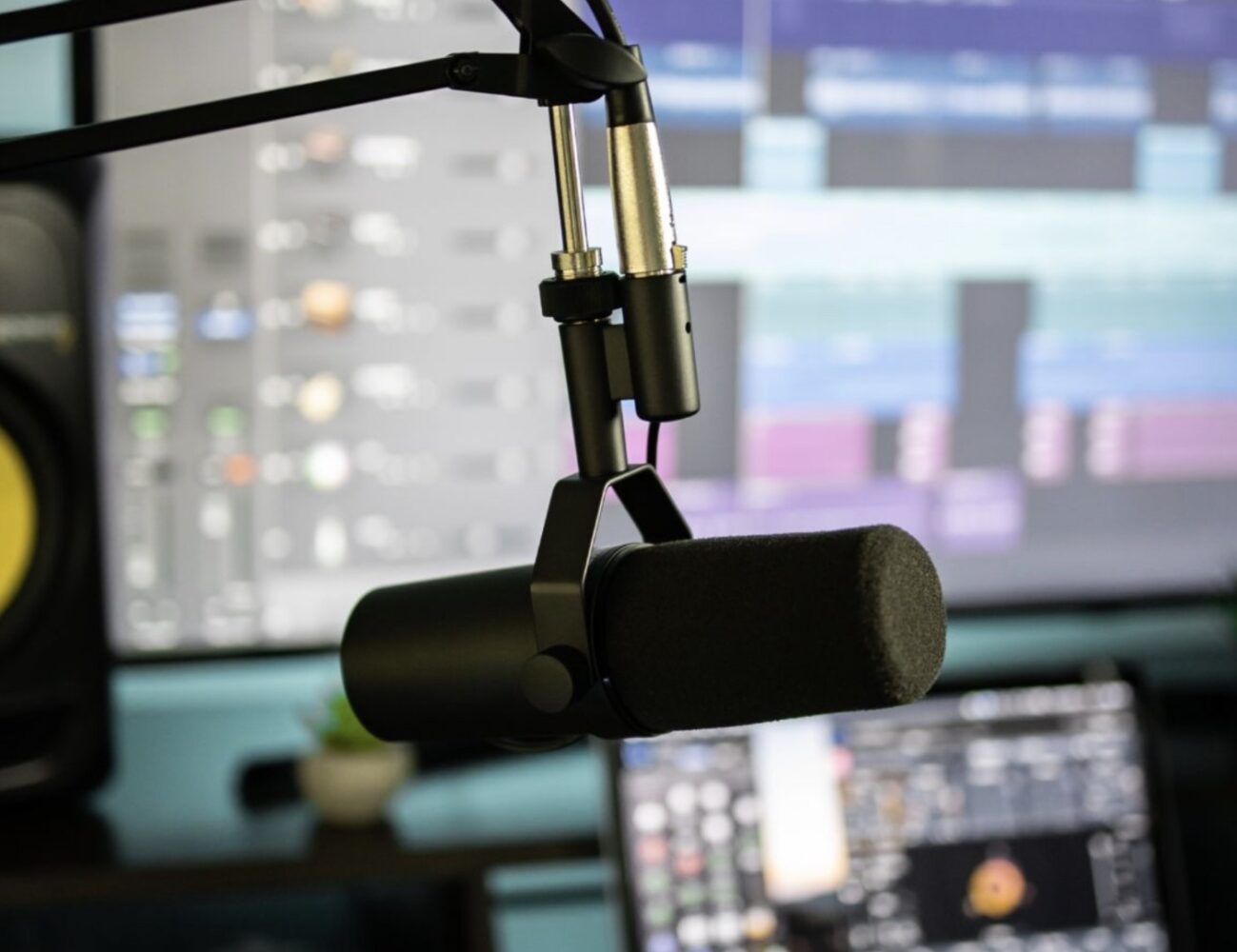
Photo by Elijah Merrell on Unsplash
Once you have an excellent microphone, you may wish to look into a recording software like Riverside or Squadcast to allow for better recording quality than a tool like Zoom.
Specialized podcasts platforms like these facilitate local recording for both you and the guest. As a result, the audio and video are not compressed, which is likely to happen with Zoom or even Google Meet.
Choosing your podcast’s video background
I advise against blank walls and virtual backgrounds. They give the impression that you either couldn’t be bothered doing more or that you’re hiding something.
Instead, have depth of field in the background so that there is more interest in the video than just your “talking head”. Place yourself 1 meter away from the camera, and have furniture and decorations behind you at a distance of 2 to 3 meters.
Jay Clouse’s setup is simple and yet beautiful
I set up my podcast with a physical backdrop, and it serves me well for podcasts as well as for my virtual meetings.
How to invite guests
As you start a podcast, I would highly recommend inviting “lower stakes guests” first – folks in your network who match the profile of the kind of guests you’re looking for, but are not celebrities.
Why start with more “casual” guests?
a) As a new podcaster, invites to more “famous” guests are more likely to be rejected. But once you establish your podcast, you’re more likely to get bigger names.
b) If you lack podcast experience, you’ll make a lot of mistakes at first. And you don’t want to make high-profile guests watch your growing pains!
When you schedule guests, my advice is to not record more than one episode a day. Moreover, avoid scheduling many episode recordings close together – you want to allow time to review each episode. Analyze what you’ve done well and then improve for next time.
How to deliver great podcasts
Plan out the different segments that each episode should have, and loosely plan what you’ll say. Let’s dive into segment planning — conceptualization — and then your talking points.
Conceptualization
I’ll take you through one of my episodes then summarize this advice so it’s easy to remember:
Episode Glimpse
I start off with a glimpse of what the episode holds. That’s usually one or two interesting quotes by the guest.
Podcast Intro
Then I introduce the podcast, which talks about what the whole podcast is about in under a minute. (I use the same intro each time).
Episode Intro
After the teaser, I have a specific episode introduction where I talk about the theme of the episode and introduce the guest.
Interview
Next, I go straight into the podcast interview itself.
Podcast Outro
I end each episode with a podcast outro, which shows the audience what the next steps for them could be to get in touch or work with me.
Talking points
For the interview itself, I write bullet points to refer to while recording. Do note that I never recommend scripting out full sentences!
I write out some of the key questions that I ask guests – but leave room for improvisation.
My aim is not just to be an interviewer but also a contributor to the conversation. I ensure that I bring my own stories, insights and expertise to the topic.
Have a concrete plan and a single topic for each episode to maintain coherence and engage your audience effectively.
Pro-tip: A lot of podcast hosts introduce the guest while they are there on the screen with them, live. I find that approach a bit awkward… The guest is left staring at you and smiling stiffly as you sing their praises, so I prefer to record the intro outside of my conversation with each guest.
Hire experts in podcasting
Lastly, to ensure the best delivery, get help from a podcast editor who can help you, especially in the beginning. You may hire an audio editor or a video specialist to create the most professional-looking podcast. Any professionals you bring on board will help more than you can measure, with expertise and advice.
| Mistakes I’ve seen amateur podcast hosts make: 1. Sticking rigidly to the question list. Imagine their guest has said something, and instead of acknowledging and building on it, the host moves onto the next question. This feels totally unnatural. 2. Becoming question-askers. The audience doesn’t assign much value to question-askers. We need to hear from their experiences if each episode is going to build their brand. 3. Publishing the first recorded episode. The first few recordings are going to be awkward, so do some test episodes with people like your friends and family to get into the flow of asking questions, improvising and responding with your own ideas. Before you want to launch your podcast, have three or four episodes recorded, edited and ready to go. |
Building podcast distribution
You have to distribute a podcast for it to be a worthwhile use of your time. If your goal is to attract potential clients, to draw in sponsorships, or most importantly — build your brand, just putting up a branded podcast on a public platform does not guarantee distribution.
Don’t worry, I’ll show you how to get your podcast heard by your ideal clients.
How to get your podcast to the right target audience:
- Share episode teasers on socials.
These could be video extracts from the longer podcast episode or a trailer that shows what people can expect if they listen to the podcast.
- Collaborate with other podcasts.
Do some cross-marketing with podcasts that serve a similar audience to broaden your reach. You can run a teaser for the other podcast on yours in exchange for them publicizing you. - Plug your podcast every time you speak anywhere.
Use every opportunity to talk about your podcast – when you’re on other podcasts or even when you’re doing your next presentation or webinar. My only disclaimer here is to talk about your own podcast in a tasteful way when you’re on someone else’s podcast. - Lean into your email list.
If you have one, start emailing them with episode announcements. Alternatively, set up a landing page to collect people’s details (and permission to market to them). You can start with simple “new podcast live” emails and build up to more advanced email marketing. - Set the expectation that guests publicize too.
I do this by sharing materials with the guests ahead of time — a video teaser to post and a link to their episode so they can help you distribute however they feel comfortable.
How to make money with your podcast
Now you’ve set up a podcast…You need to keep it going! You need to justify the time spent recording, planning, editing, and marketing. So how can you make an income with your podcast? For beginners, I’d recommend these 4 ways:
1. Attract sponsors
How do you grow your podcast enough to get sponsors?
Growing a podcast and attracting sponsors involves a combination of strategic planning, consistent effort, and creating valuable content. Here are some steps you can take to grow your podcast and attract sponsors:
- Focus on quality. Much of what’s required to attract sponsors is quality content. A loyal following is evident in your comments, subscribers, and how quickly your podcast episodes are consumed.
- Encourage listener reviews and ratings, and familiarize yourself with podcast analytics to understand your audience demographics, listener behavior, and download numbers. This information shows true connection when pitching to sponsors.
- Create a media kit that includes information about your podcast, audience demographics, download statistics, and any notable achievements. Have this handy to share not only with potential sponsors but popular podcast directories. This will help you practice pitching sponsors, and may even attract a sponsorship offer organically.
Once you have a solid listener base and meaningful metrics, start reaching out to potential sponsors.
2. Employ memberships
Here’s a channel to making money with your podcast that you might not have considered. It limits your dependence on sponsorships with big companies that will want a say in your content.
- Listener support platform Patreon or Buy Me a Coffee work. You can encourage your audience to contribute a small amount per episode or on a monthly basis to help sustain and improve the podcast.
- Premium content with a membership program where subscribers pay a fee to access exclusive episodes, early releases, or special behind-the-scenes content. This works well to build an even more loyal following.
3. Consider it self-marketing
You might choose to see your podcast as a marketing channel for your business. In this sense, your investment in starting the podcast will not be recovered via said podcast, but by the brand building that grows your primary business.
Do you have a course or consulting service for sale? You can promote it on your own, personal marketing channel to a captive audience. (Just promote it well by weaving it into the content instead of just turning it into an ad).
You’re ready!
Now that you know in depth how to start a podcast, a final word of advice:
Don’t be concerned if it takes a few episodes to get into your flow. It’s not easy being completely present, listening to the guest, improvising and moving on to the next question. It’s really an art and a skill that you will need strategic practice to learn.
Starting a podcast is not just about talking; it’s an intentional activity to amplify your brand and can leave a lasting impact on your audience. That’s why I offer 1:1 coaching and bootcamps to have you speaking as a leader.
I wish you all the luck and joy I found in exploring the podcasting landscape and building a compelling brand.

